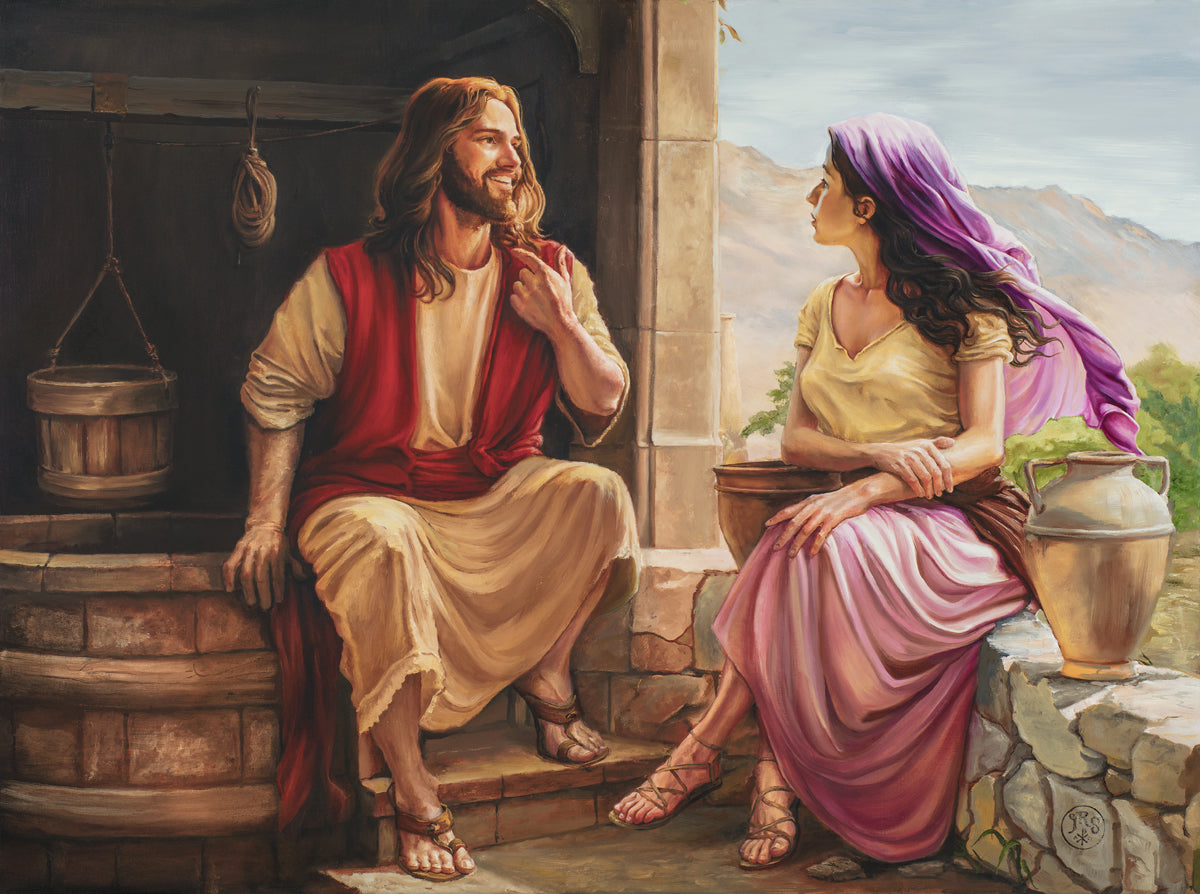Unexpected Grace: Revelation at Jacob's Well Large Wall Art
In "Unexpected Grace: Revelations at Jacob’s Well," artist Jordan Ring-Sakabe seeks to vividly illustrate the pivotal encounter between Christ and the Samaritan woman. The painting is set at the well, a central metaphor in the narrative, with Christ seated thoughtfully on its rim. He embodies a sense of calm authority and profound wisdom. His posture is inviting and open, suggesting a deep engagement in the conversation. His gaze is intense yet compassionate, directed towards the Samaritan woman, signifying his concern for her spiritual welfare.
The Samaritan woman is portrayed with striking vividness. She stands opposite Christ, her body language a mix of curiosity and astonishment as she processes the profound truths being revealed to her. Her attire is richly colored, with luxurious hues that suggest a history of being sought after and adorned by many men. These colors, however, also hint at her experiences of abandonment and separation, weaving a narrative of her complex personal history.
Christ, in stark contrast, is depicted as a beacon of light in the darkness. The artist uses a dramatic contrast between light and shadow to emphasize Christ's role as the spiritual light in the woman's life of relational and moral darkness. This contrast is not just physical but also symbolic, highlighting the difference between the transient satisfactions of worldly relationships and the enduring fulfillment offered by Christ.
The well itself is more than a physical structure in the painting; it symbolizes the depth and source of living water that Christ offers. The well's stony textures and solid form stand as a testament to the enduring nature of Christ's teachings, juxtaposed against the ephemeral pleasures and pains of worldly life.
Overall, the painting is a rich tapestry of symbolic elements, color, light, and composition, all working together to bring this biblical story to life. It invites viewers to contemplate not only the historical encounter but also its deeper spiritual implications – the transformation available through Christ and the living water he offers for eternal well-being.
Jordan Ring-Sakabe presents the viewer with a compelling painting that captures a pivotal moment in Christ's ministry. This artwork delves into the profound spiritual and emotional dimensions of Christ's encounter with the Samaritan woman, a narrative rich in Christian faith and theology found in the gospel of John 4:1-42. The artist aims to encapsulate five key themes through this painting:
The Redemption of Sinners: The artist portrays Christ's compassion and understanding towards those who have deviated from traditional moral norms, particularly in matters of marital and sexual ethics. This depiction emphasizes Christ's knowledge and unconditional love. Christ's omniscience takes a symbolic portrayal in this piece as seen in the wind that blows through the Samaritan woman's hair and headdress, revealing that for God, there is nothing hidden nor secret. Similarly Christ's unconditional love, which transcends human faults and failings takes center stage in this work of art, reflecting the notion that Christ sees beyond our secrets and offers healing and acceptance, portraying a divine embrace of sinners that encourages them to rid themselves of the addictions, pains, and sufferings of sin and find healing in Christ's passion.
Spiritual Nourishment: Central to the painting is the theme of Christ's teachings as a source of spiritual nourishment. The encounter at Jacob's Well is artistically rendered to symbolize the quenching of thirst alongside the deeper fulfillment of spiritual and emotional needs. The artwork highlights Christ as the provider of living water that nourishes the spiritual aspect of human existence.
Breaking Social Barriers: In this a striking narrative, Christ, a Jew, is shown engaging with a Samaritan woman, challenging significant socio-cultural barriers of the era. The painting serves as a powerful testament to God's inclusive love, transcending divisions of race, gender, and social status. It symbolizes God's universal outreach, emphasizing inclusivity and unconditional agape love that doesn't merely accept the sinner, but guides them to the source of living water, freedom, and redemption.
Symbolic Naming: According to Catholic and Eastern Orthodox tradition, the Samaritan woman's name holds deep symbolic significance. While not contained in the bible, the name "Photini" or "Photine" has been passed down through Christian tradition and she is venerated as a saint. The name Photini symbolizes the spiritual enlightenment she received through her encounter with Jesus. The artist weaves this understanding into the painting in the manner in which he portrays Photini surrounded by the light of the background. This in effect is intended to invite viewers to ponder the transformative impact of divine encounters on personal identity and suggests that names and identities gain profound meaning in the context of spiritual metamorphosis.
Emotional Depth and Sacramental Theology: Departing from conventional representations of this biblical story, the artist presents Christ as an emotionally expressive figure, full of eagerness and compassion. This emotional richness signifies Christ's fervent desire to lead humanity towards redemption and grace. The painting depicts a dynamic and heartfelt dialogue, marking the beginning of a transformative journey enabled by the sacraments and personal volition. It powerfully illustrates Christ's role as a guide and redeemer, eager to alleviate the burdens of sin and guide souls towards a path of grace and redemption.
In "Unexpected Grace: Revelations at Jacob’s Well," the artist not only recreates a biblical episode but weaves a complex tapestry of themes central to understanding Christ's ministry. The artwork invites contemplation and spiritual reflection, offering viewers an immersive experience into these layered meanings.
Reproduced from the artist's original artwork of oil on canvas.











